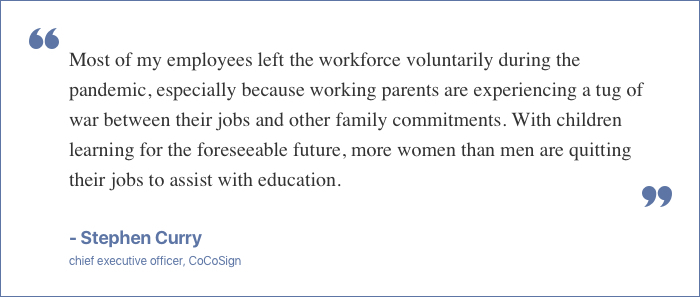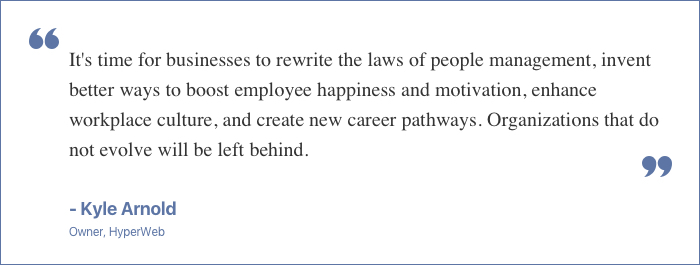Abstract:
The COVID-19 pandemic epiphany has triggered people to quit their jobs, precisely wanting more money, more recognition, more flexibility, and a more healthy, and relaxed work atmosphere. The impact is severe and is likely to affect the market badly. We have workers who faced the pandemic layoffs, sailed through the contemplated job, and took up remote working underpaid, overworked, and underappreciated. So, are these people quitting their jobs? And, is there a job hop because there are many job openings created after the pandemic? Are people hopping jobs to pick up one that was out of reach earlier?
Are the companies expected to act strategically to retain and attract talents and reimagine work culture? Do they have to revise management and talent acquisition practices? Should they give more preference to specialists or skilled workers without bothering about the boundaries? Should they adopt the policy of flexible work, flexible everything? Should companies focus more on creating value for the employees rather than using employees for the company's benefit?
Can the employees stop lying flat, assuming this to be a time for worker’s revolution, or rather re-shuffle? Are they ready to retain their current job if there is an assurance from the company of their well-being and engagement?
Too many discussions are ruling the news column. It is time to move from mere prediction to swift experimentation. So, who exactly can stop this unstoppable great resignation? Will this continue to grow further? To gain more insight on this, GoodFirms conducted an online survey between 15th November 2021 and 22nd November 2021. A total of 416 responses were collected. The survey queried employees and HR managers across the world to know the current status of their employment, factors causing the great resignation trend, attributes that influence employee retention, and techniques to combat the employee turnover challenges.
Table of Contents:
Introduction
The Employee Attrition Rate has Increased after the Pandemic
Elements Driving Employees to Quit: GoodFirms’ Survey 2021
- The Transition from Work from Home to Work from Office
- Pandemic Induced Burnout
- Vaccine Mandates
- Fear of Infection
- Lack of Flexibility
- Salary and Growth
- Manager Behaviour
What Can Organizations Do to Retain Staff?
What Employees Can Do From Their End To Stop Hopping Jobs?
Key Findings
Conclusion
Introduction
While companies are still reeling under the effects of pandemic-led transformed business environments, the increasing attrition rates are adding more blows to their already struggling bottom lines. The phenomenon has been widely termed as the great resignation, the great reshuffle, the turnover contagion, the big quit, the great reckoning, turnover shock, or the great attrition. Anthony Klotz, the psychologist who coined the term great resignation, terms the phenomenon as a pandemic epiphany that started in the USA when 4 million employers quit their jobs in April 2021.(1) In August 2021, the number went up by 4.3 million. Linkedin has been the testimony to several job walk-out posts that went viral in 2021.
Whether we call it the domino effect or mass exodus, the reality is grim and frightening.
This survey by GoodFirms titled: 'Who Can Stop this Unstoppable Great Resignation' aims to help employers better understand how the employee perception has changed with the pandemic and what it will take for employers to engage, nurture and retain their talent in the future.
The Employee Attrition Rate has Increased after the Pandemic
The increase in the attrition rate is negatively impacting all industries. GoodFirms surveyed HR managers to understand the current state of employee turnover in various industries. IT emerged to be the worst-hit sector due to high levels of attrition rate prevailing in the industry. Global triggers and pandemic-led change in employees’ perception, expectations, and work behavior are factors responsible for unprecedented levels of attrition in the year 2021.
The great resignation wave is the result of autonomy that employees have regained due to the resurgence of jobs in the aftermath of the peak-pandemic period. There are more jobs available in the USA than ever, and employers are scrambling to find workers.
Most of the Current Employee Turnover is Coming from Voluntary Resignations
Even when organizations are holding back layoffs or firing as a part of policy and also due to a lack of skilled talent to replace the current ones, there are many who are putting their papers down voluntarily.
As per the surveyed HR managers, voluntary resignation is currently the prime source of employee turnover. What is interesting is that the reasons behind resignation are not only monetary in nature. Work-life balance is turning out to be the elephant in the room. Employees who earlier prioritized work planned their weeks based on work calendars, socialized only on weekends and off-days, skipped parent-teachers meet for work, or compromised leaves for compensation benefits have a new perception towards work and life.(2) The unpredictability of life has caused many to change their outlook and reflect on what really matters to them?
Many are leaving their jobs due to reasons ranging from demand for job flexibility, learning, reskilling, mental well-being, health concerns, and more. The great resignation trend is devastating organizations that have to pay a heavy price for turnovers.
Elements Driving Employees to Quit: GoodFirms’ Survey 2021
The big quit phenomenon is something that didn't happen overnight. A majority of the workforce had been living in silent agony and the pandemic just made them realize it. High disengagement at work led to resignations across the sectors, including the service workers, blue-collar workers, and white-collar workers. Many who were already considering quitting their jobs reached the tipping point when they were supposed to join the office back. We surveyed and analyzed the top factors that are influencing employee perception and priorities post-peak pandemic leading to the great resignation trend:
Life-Shocks and Turnover
Life events have a major effect on the working situation of people. For example, childbirth, divorce, marriage, family separation, deaths of near-ones, etc., are events that may cause people to rethink their job priorities and self-reflect on work-related situations. While all these are generally isolated cases and won't increase or decrease a company's attrition rate dramatically, the pandemic resulted in these cases happening en masse. For example, many leading legal firms in the USA reported increased divorce inquiries during the peak-pandemic period.(3) During and in the aftermath of peak-pandemic, millions of people witnessed major life events simultaneously, and therefore, reevaluation of their conditions led to a sea of resignations worldwide.
Opting for Companies that Offer More Flexibility and Better Opportunities:
Great Resignation is also a great reshuffle. There is a larger shift in the worker's mindset about how and in what work settings they want to work. Many employees who enjoyed flexibility during the pandemic are now reluctant to work from the office. People are resigning from companies (that, due to traditional outlook or technological limitations, cannot offer flexible work environments to their employees) and joining other companies (that provide better opportunities, work-from-home setup, flexible working hours).
Re-evaluation of Life Priorities:
Pandemic created a space to rethink priorities. The pandemic may have taught people what matters most in their life. Many employees are reconsidering their life goals, work goals, and personal goals. Many moved to suburbs to enjoy green pastures, others started pursuing their hobbies and turned them into full-time careers, many started freelancing to spend more time with their families, some started their own startups, and many others shifted to unconventional careers such as trading cryptocurrencies, NFTs, etc.
Employees Discover New Skills and Platforms:
Many people who were working from home or were rendered unemployed discovered other platforms and freelancing work that enabled them to work more flexibly and on their own terms. This is another reason why employees do not feel the need to work in the 9-5 stringency. Also, due to newly acquired skills (discovered during the pandemic), many want to quit their current job and pursue freelancing career options that started as a side hustle during the pandemic. In the great resignation fuelled passion economy, many are quitting their jobs to follow their passions.(4)
Seeking Upward Mobility
Many employees are leaving their current organizations due to the lack of upward mobility culture. Many employees who have stayed longer with their current employers without being able to bag promotions, higher designations, etc., are now moving to other organizations where upward mobility is customary. Employees who have been caged up on the same level and position for long enough are now reexamining their work lives and attempting resignations if not awarded their due on an immediate basis.
Mental Health and Emotional Well-being is a Priority Now
COVID-19 offered a wealth of insights into employee wellness, changing the definition of mental and emotional health at workplaces. Lockdown made many despondent. People got anxious about life and the future. In a bid to cope up with the anxiety, many developed mechanisms such as spending time on a life-long dream project, initiating a new hobby or introspecting self-worth, etc. (Activities that foster emotional and mental well-being).
21.2% Employees Are Planning to Leave their Current Job While 29.8% are Unsure about it
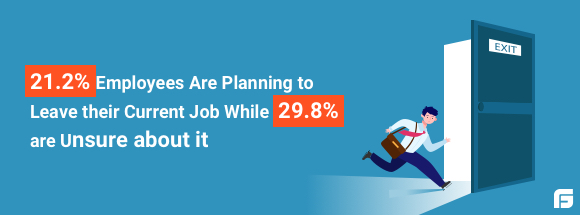
Other Factors Influencing the Great Resignation Trend include:
- The Transition of Work from Home to Work from Office
- Fear of Infection
- Pandemic Induced Burnout
- Vaccine Mandates
- Lack of Flexibility
- Monetary Reasons
- Manager Behavior
- Other Reasons
The Transition from Work from Home to Work from Office
Whether the Transition from Working Remotely to Working From Office is Taking a Toll on Employees?
33.7% Employees Still Want To Work From Home
While it is a common notion that work-life balance is strengthened if workers work from the office as household worries are eliminated during work hours, it is not the case with 33.7% of employees. There are many reasons why 33.7% may still want to work from home. So the question is if the transition from working remotely to working from the office is taking a toll on employees?

When the pandemic subdued, many employees started wondering if they would have to get back to physical offices. Now when offices have resumed for many, many are coping with an acute dilemma. Those who were equally productive, perhaps more productive during the remote work phase, find work from the office setup futile. Many other reasons combine together for people who still prefer WFH more than WFO.
Longer Commute Time:
For many who commute longer than others, working from home came as a boon. Now, they find going to the office troublesome. Also, people can spend more time with their family by working from home.
Expenses
It also means savings on daycare, traveling expenses, fewer expenses on office attire, etc.
Comfort for People with Chronic Illnesses/underlying health conditions
Remote work also saved people from infection, air pollution. WFH is also an easier option for people with chronic illnesses such as diabetes, Asthma, etc.
Side Jobs
In work from the home pattern, many may continue side hustles, which is not possible in work from an office setup.
Schools are not yet fully functional due to which either of the parents has to opt for work from home facility.
Pandemic Induced Burnout
Is Your Current Staff Reeling Under the Pressure of Pandemic-Induced Burnout?
30.7% Employees Are Frequently Stressed And Feel Burnout
30.7% of people reported frequent stress levels and burnout during work in the post-pandemic work environment. Organizational policies impact employees’ stress levels directly. Organizations that haven’t updated their policies to adapt to the post-covid work environments have high chances of having employees with elevated stress levels.

16.35% of employees find themselves overburdened
Due to great resignation and mass exodus of employees, many organizations are left with an inadequate workforce. This spills the pressure on the fewer employees who have to handle more workload. Also, due to financial restraints, many employers are trying to manage with fewer employees, and this is putting the burden on current employees. 16.3% of employees reported being unreasonably overburdened.
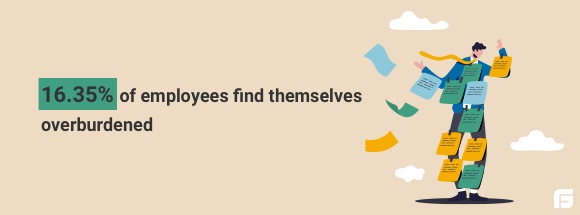
23.08% of Employees Feel Mental Depression Sometimes
WHO reports a loss of $1 trillion in productivity due to mental health-related disorders.(5) Organizations where mental health is not discussed or prioritized have workers who face mental depressions.
Factors that are causing psychological distress in the post-pandemic era include:
- Inadequate health and safety measures
- inflexible and lengthy work hours
- Perception about the risk of contagion at the workplace
- Worry about social stigma and exclusion if contracted by the virus
- Financial losses in the pandemic period
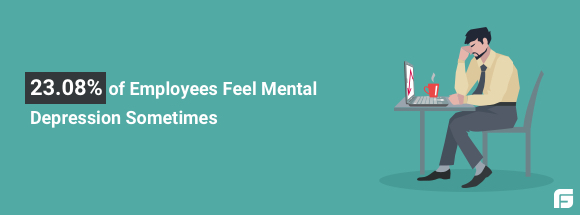
The catastrophic experiences employees had during the epidemic–unavailability of transport, shortage of essentials such as masks, sanitizers, toilet papers (6), food, etc., isolation, inability to meet the near-ones, and deaths of relatives, etc. are still haunting many employees.
17.31% Employees Think They Can Do Better If They Leave The Current Job
The pandemic has caused employees to rethink their current position, skill sets, and career advancement goals, and many are reconsidering their career objectives. 17.3% of employees believe they can do better by job-hopping. One reason for this is that many employees learned new skills during the pandemic. While working from home, many managed to do certifications, courses, and training to reskill themselves during the pandemic. With new skills and enhanced knowledge, employees believe that they can hunt for better opportunities. Another reason why many employees feel they can be better positioned if they quit their current jobs is that due to the pandemic, many employees didn't receive any substantial increment; many are even working at deducted wages. Therefore, hopping jobs seems a profitable step for these employees.
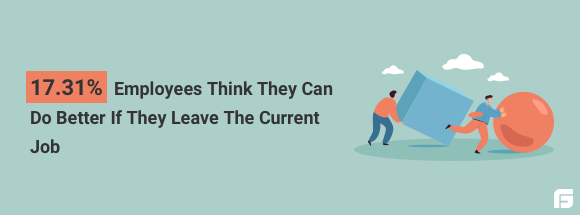
Vaccine Mandates
57.6% Employees Voted in Favor of Vaccine Mandates From Employers.
Employers in many countries have imposed vaccine mandates on their employees. Those not complying are being fired or put on unpaid vacations. Others have to go through weekly testing to keep up their job. Inoculation against COVID 19 is a desirable situation; therefore, not imposing mandates for vaccinations may put employers in an unenviable position. However, it turns out that most employees (57.6%) support vaccine mandates from employers.
Employees feel safer when employers have policies in place to make sure that employees coming to offices are vaccinated. Similar outcomes came in the IPSOS survey for the World Economic Forum, where most employees are in favor of vaccine and mask mandates. (7)(8)

Fear of Infection
37.50% Employees Still Fear Getting an Infection While Working from the Office
The advent of various new variants halted the smooth entry of commuters to offices. The fear of infection is among the vaccinated too. This gets reflected in the fact that 37.50% of employees surveyed by GoodFirms reported fear of getting infections while working from the office. The trepidation can impact mental health, productivity, and an employee's overall work profile. Of many other workplace aspects that impact employees' mental health, the pandemic-induced fear of infection is currently reigning supreme. The fear, even as many medical practitioners say is 'psychological,' can be a deterrent to productive work environments.
Lack of Flexibility
70% of HR managers surveyed reported flexibility of work as the most cited reason for resignations.
Flexibility Becomes the Most Cited Reason For Resignations
Pandemic's greatest impact on the business world was 'shift to remote work.' The pandemic afforded unprecedented flexibility. People accustomed to it cannot fathom returning to work from office mode. Therefore, inflexible employers are struggling to keep up their workforce. Employees are demanding flexible work hours, options to compress or expand work schedules, alternatives for working from home or office, and more. Organizations unable to accommodate flexibility options demanded by employees end up losing them.
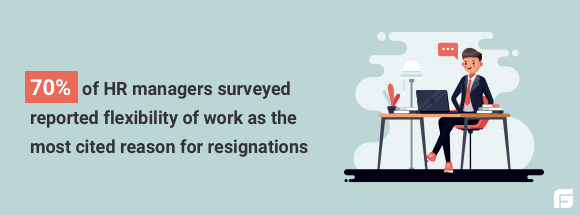
Salary and Growth
21.1% of Employees Are Not Satisfied With Their Current Salary
There is a fundamental shift in employees’ expectations fuelled by new job opportunities that aren’t limited by location. Earlier, employees had a limited scope of jobs as geographical boundaries curtailed their job search endeavors. However, with remote work, employees can find global opportunities while sitting at their homes.
The rising costs of utilities, food items, travel, housing, medicare, etc., are creating stress on the household budgets of employees. Employees with average salaries feel less motivated and discontented. Without long-term growth prospects and immediate appreciation hopes, employees who are not satisfied with salaries may switch their jobs.

25.9% of Employees Are Unsatisfied With Their Increments And Promotions
Citing pandemic-led financial crunch, loss of revenues, and meager profits, many organizations halted the appraisal process altogether; some delayed it beyond employees' patience, others went to appraisals that were far below employees' expectations. 25.9% of employees surveyed by GoodFirms are currently unsatisfied with their increments and promotions.
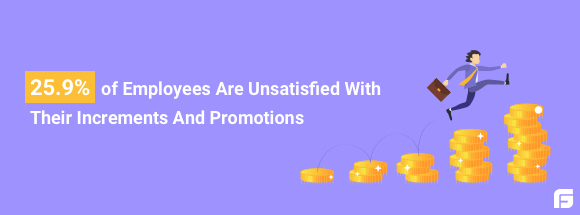
21.1% Are Not Content With Career Development Opportunities
Employees are reevaluating their job prospects with a newfound perspective. The continuously increasing competition, technological changes, and difficult business environment require people to upgrade, upskill and act proactively to sustain the uncertainties of life. Career development is now taken seriously by employees, and the zeal to develop one's competencies is greater than ever before. Organizations that understand the importance of employee career development are more likely to retain their talent. However, 21.1% of employees are not content with the career development opportunities offered by their companies. The organizations that attend to the career development goals of employees and train their workforce not only reap high productivity benefits and enhanced competitive advantage but also steer loyalty from their employees.

Manager Behaviour
19.2% of Employees Are Not Satisfied With Their Managers
Relationship with the manager is a critical factor for job satisfaction. Micro-management, disrespect, credit-stealing, blaming, failing to listen, etc., are reasons why employees start to hate their workplace. Even when employees love their work, differences with bosses can make them unhappy, unproductive, and stressed. Most employees facing poor handling from the manager prefer to leave their jobs rather than stand against them.
Also, during the pandemic, many employees were worried about their families, the well-being of kids, paying bills amidst financial insecurity, etc. Such anxieties decrease the productivity of human beings. Managers who failed to show empathy towards employees and kept demanding productivity became the reason for many leaving their jobs.

Other Reasons:
‘Thinking of quitting my jobs & becoming an influencer full-time,’ Elon Musk on Twitter.
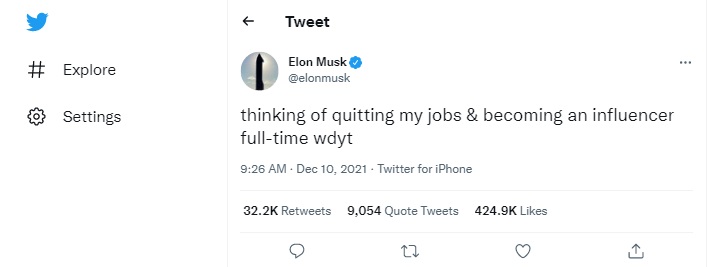
Source-Twitter
Shift to Other Job
26% of employees cited a shift to other jobs as the reason for leaving their current job. Many employees are quitting their jobs in search of the promised land at other organizations.
Starting Own Business
18.3% of employees cited starting their own business as the reason to resign. Spending extra time at home, job insecurity during the pandemic, and revived aspirations for entrepreneurship have motivated employees to consider their own businesses.
Further Education
8.7% plan to leave their jobs to pursue further education. Many employees who had joined their organizations while pursuing their education are now leaving jobs to focus entirely on their academics.
Shift to Other Location
8.7% are shifting to another location and therefore want to resign from their current job. The pandemic caused many to sell their properties and move to less expensive places.
Health Concerns
4.8% want to leave their jobs due to health concerns. After COVID19, employees are taking their health conditions seriously. Employees with poor immune systems, complicated health histories, and weaker body structures are quitting jobs that require more physical or mental exhaustion.
Unsafe Working Atmosphere
3.8% will leave their jobs due to an unsafe working atmosphere. Ergonomic hazards, biological hazards, and chemical hazards are the topmost unsafe working atmosphere aspects. After the pandemic, biological hazards that stem from bacteria and viruses have become the prime focus. Employees who may have tolerated unsafe and unhygienic working conditions before the pandemic are now ready to leave the job if safety parameters are not met.

What Can Organizations Do to Retain Staff?
While strong leadership and management, quality products and services, and impeccable brand reputation are quintessential for an organization's success, employees play the greatest role in the long-term sustainability of businesses. Businesses that wish to survive the resignation storm should quickly respond to the needs of employees.
Equity Theory: Keep the Input and Output Balanced and Fair
Primarily developed from the works of J.Stacy Adams, a behavioral scientist and workplace psychologist, the Equity theory is a popular framework supported by research to guide employee perceptions towards their organizations. The theory builds its premise on the thesis that Employees who feel undermined, unfairly treated, and poorly rewarded will leave their organizations.
Employers need to balance input and output to unleash higher satisfaction levels from employees. Inputs from employees such as initiatives, hard work, commitment to organizational goals, skills, adaptability, teamwork, etc., should be balanced by outputs from employers such as increased salaries, perks, flexible working environment, appreciation, promotion, job security, etc.
Another aspect of equity theory is the fair distribution of resources and creating equal opportunities and benefits for all irrespective of any difference based on gender, bias, or demographics. Maintaining equity in everything that the organization does keeps employees motivated and satisfied. The rising divide in wages, automation, and the pandemic compelled employees to seek organizations that provide upward mobility. Businesses that want to save their workforce need to act boldly, urgently, and decisively. Employers should start eliminating the gender-based pay gap (by offering equal pay to both genders), skill-based pay gap (by reskilling employees), and demographic-based pay inequality (by bringing standard pay policies across regions) on an immediate basis.
Build Safe Office Environment
OSHA (Occupational Safety and Health Act), USA, makes employers responsible for creating a safe office environment wherein employees can work without the threat of death due to infection or any other physical harm.(9) Proactive and concerned employers should facilitate the employees' in getting vaccinated. Employers can provide surgical masks, sanitizers, immunity-boosting food, etc., to make employees feel safe. Employers need to adhere to standards aimed at preventing ATDs (Aerosol Transmissible Diseases) that spread via air. Also, create policies that make employees feel more secure- such as quick notifications if someone tests positive in the staff, mandatory disinfectant processes, response and shutdown protocols, configured seating arrangement to ensure social distancing, temperature checks on arrival, etc. Research also suggests that healthy buildings can stop COVID19 spread and make employees feel more secure.(10)
Offer Flexibility and Hybrid Work Options (WFH/WFO)
Organizations should understand that during the lockdown or quarantine period, the productivity of employees didn't go down, and therefore, forcing full-time office models in the aftermath of peak pandemic is not justified. Companies can offer hybrid work options with three days in the office and two days at home or vice versa. Losing employees over rigid policies will not work in favor of employers.(11) Organizations cannot continue with the one-size-fits-all mentality anymore. When the pandemic started, organizations spent huge amounts of money to facilitate remote work and bought software programs to set up remote work protocols.
The work continued due to employee compliance. Employees were quick to adapt to the new patterns, and many sacrificed their personal spaces to convert them into office stations. However, now employers are expecting employees to hurry back to onsite locations. This could result in a disaster. Employees must be treated with a personalized approach, and organizations must consider the unique needs of each employee before fixing work options. Hybrid work options should be given to employees where they can choose to work from home or from the office as and when required by them. The IT department must be rolled in to make the working experience easier, secure, and more enjoyable for employees. Computing environments for both home and office must be powered by VPNs, RDPs, and VDIs to create a similar working environment at both places.(12)
Transform Company Culture:
Organizations need to facilitate company culture by involving leadership, management, and employees in the process. The goal is to make the workplace better for employees. Thriving the great resignation requires organizations to adopt an introspective attitude towards their policies, procedures, behaviors, and commitments towards the employees. Businesses should strive to create an inclusive work environment where employees are considered as assets and not liabilities.
Plan for Regular Team-Building Exercises:
Activities such as virtual team building, games, happy hours, etc., can help employees boost their moods and eliminate stress. Activities are more essential with remote workers. Activities with fellow teammates act as positive reinforcement and build a sense of shared identity and goals.“Team building activities should be planned, designed, executed, and monitored in such a way that will enhance open communication, members’ collaboration, and flexibility in order to create effective cohesion and synergy to enhance team effectiveness and performance.”(13)
Educate Employees for COVID Policies, Protocols, and Safety Procedures
Employers should train employees to follow COVID-related protocols, safety standards, and policies. In the event of a COVID attack, good safety habits and training can go a long way in protecting employees. Preparing employees on the COVID protocols and safety procedures is essential to ensure a safe and secure workplace. All employees should be trained on basic COVID protocol to keep themselves and their colleagues safe. If you don't want to lose your employees to a COVID attack, make sure they're fully educated about how to stay safe.
Today’s workforce is becoming increasingly diverse. This diversity brings new perspectives and ideas to the table, which can help your business grow. The different perspectives also mean that employees come from different backgrounds with different beliefs, especially in regards to what they know about workplace safety. Ensuring that your workforce is accredited for COVID compliance is imperative to ensure the safety of those who work in your facility.
Gratuity Benefits
70.1% of employees surveyed by GoodFirms reported that their organization doesn’t provide gratuity benefits to them. Offering gratuity benefits can help create a more enjoyable work environment for your employees. Gratuity can be offered through many different methods. From cash given at the end of each shift, food cards provided on a monthly basis, or an annual bonus at the end of the year, Gratuity offerings have been shown to incentivize higher productivity and performance in employees.

Sufficient Maternity/Paternity Leaves
30.7% of employees said their organization doesn’t provide sufficient maternity/paternity leaves. Parental leaves are an essential part of how we care for one another as humans. It is important to provide employees with sufficient maternity and/or paternity leave so they can bond with their children. Providing employees with adequate family leave has many benefits for both employer and employee.
Easy Leave Policy
23.8% of employees do not enjoy an easy leave policy. Offering leave whenever required by employees is a great way to support them. Easy leave policy assures employees that they can take time off work whenever they have to meet personal, family, or other related obligations or whenever they have other emergencies for medical purposes, travel, etc.
Provide Childcare Facility
Only 9.6% of organizations provide childcare facilities to employees. WFH can be a great option for many professionals. However, it does not solve the childcare issue. There's a greater need for child care services that offer convenience and flexibility to parents. Providing a daycare facility will reduce stress, help your employees get more done, and it can help with retention and recruitment efforts. If you provide childcare, you'll attract and retain talented workers who might otherwise be turned off by the logistical challenges of child care. This is beneficial for both you and your employees in the long run. Building an onsite daycare center is costly and time-consuming but necessary if you want to attract top talent because many parents prefer this option. Providing childcare services to your employees is an investment in your company's future.
Transparent Salary Structure:
Organizations need to be transparent about salary structure and compensation benefits. HR managers should clearly define salary adjustments for remote workers, variations based on locations, etc. The “Transparent salary structure” concept leads to a more trusting work environment with better productivity, creativity, and collaboration. Employers often have a pay range in mind for each position but are reluctant to disclose that information with their employees. The lack of transparency in salary structures is problematic because it leaves people guessing about how much they should be expecting in return for their work.
This is because it provides transparency and fairness in the workplace and allows everyone to know what their peers and superiors make. It makes it easier for employees to find out if they are being paid unfairly or should be negotiating for more money. When employees understand how much they earn, they feel appreciated and valued by the company, which leads to increased employee satisfaction, engagement, and productivity.
Hire Gig Workers
The loss of an employee is always a setback for the company, but it can be even more damaging when there's no replacement in the pipeline. The solution to this problem lies in hiring gig workers, which are people who provide services on a freelance basis. Many full-time employees have foregone social security benefits, retirement provisions, etc., and have turned to contractual work. As the traditional workforce is changing, the gig economy is becoming more popular. Companies should open jobs for gig workers to fight their great resignation problem.
Deploy Retention Strategies
Transactional relationships with employees will last only till they receive their paycheck. However, relational association lasts beyond office time and paychecks. Employees that feel connected with companies stay longer with them.
- Organizations should drive value for the long term
- Conduct regular one-on-one meetings, plan for a monthly review party, regular video calls for engaging employees positively
- Increase recruitment budget, invest in recruitment technologies such as recruitment software, etc.
- Provide employee benefits such as life insurance, medical insurance, free transportation from office to home, training and development, career growth opportunities, paid leaves, accommodation facilities, etc.
- Evolve operating models to lower employee stress and burden
What Employees Can Do From Their End To Stop Hopping Jobs?
Job-hopping is an understandable situation. Many employees stay in their jobs for a brief or median period only. The decision to quit jobs in a short period of time and shift to other jobs is fuelled due to many reasons specific to individual employees.
Employees should consider a few things before hopping their jobs:
Is your goal clear?
Before you shift positions or resign from a place, make sure your objectives about career, life, and work priorities are clear.
Focus on what really matters to you?
Rather than trying to get multiple benefits from the job, focus on a few that really matters to you. For example, if a company is offering you insurance, travel expenses, accommodation, childcare, and a good salary, but a flexible work option is not available, and if flexibility in work hours is a critical element for you, then it makes sense for you to deny such offers. Similarly, if the salary is a bit less, but other facilities are attractive, then accepting the offer can be beneficial to you. It rounds to only one factor - focus on what really matters to you.
Keep Empathy Towards Your Boss
Even the strictest bosses are not inherently bad people. They are people with human flaws. Keeping an emphatic attitude towards your boss will help you understand the true nature and the soft side of your supervisor. Empathy can solve cross-cultural issues, communication gaps, and misinterpretation of facts, and other emotional conflicts between you and your manager.
Identify Companies That Set Example During Pandemic:
Pandemic was a mirror that compelled many deceptive faces to unveil their true nature. Employees should identify and apply to organizations that helped, supported, and covered for their employees during the pandemic.
Whatever the trigger may be for this great resignation, the market will soon witness an improvement in the work world, and workers are likely to bring the best out of them, crafting a career that best fits their lives.
Key Findings:
- The employee attrition rate has increased after the pandemic
- Pandemic created a space for employees to rethink their priorities
- 21.2% of employees are planning to leave their current job while 29.8% are unsure about it
- 33.7% of employees still want to work from home
- 30.7% of employees are frequently stressed, and burnout
- 16.35% of employees find themselves overburdened
- 23.08% of Employees Feel Mental Depression Sometimes
- 17.31% Employees Think They Can Do Better If They Leave The Current Job
- 57.6% Employees Voted in Favor of Vaccine Mandates From Employers.
- 37.50% Employees Still Fear Getting an Infection While Working from the Office
- 70% of HR managers surveyed reported flexibility of work as the most cited reason for resignations.
- 21.1% of Employees Are Not Satisfied With Their Current Salaries
- 25.9% of Employees Are Unsatisfied With Their Increments And Promotions
- 21.1% Are Not Content With Career Development Opportunities
- 19.2% of Employees Are Not Satisfied With Their Managers
Conclusion:
The great resignation is a worker’s revolution in the true sense. It echos employees’ voices for the newfound perception of their lives. From a life that revolved around the jobs to jobs that fit into the lives that people want to live, the transition is acute. Employees now seek jobs that have remote work options, shorter and flexible work hours, 4-day work week, manageable leave options, caring organizations with a clear focus on health and well-being, etc. in short, a job that helps them maintain a work-life balance. From an employer’s point of view, the big quit is the third biggest blow to their business after pandemic-led closedowns and the subsequent supply chain bottlenecks.(14)
From restructuring compensation plans, implementing flexible work models, offering higher salaries, and allowing better work-life balance to rethinking recruiting strategies, organizations need to proactively reframe their employee selection and retention programs to survive the fluid job market. The time is to deep dive into employees’ minds and individually address their concerns before it is too late.
We sincerely thank our Research Partners who participated in the survey.
About Research
Gender
- Male -52.8%
- Female-48.2%
Age
- 18-24- 12.5%
- 25-39- 47.12%
- 40-59- 33.65%
- 60+- 6.73%
Country: 29
Are you currently working:

__________________________________________________________________________________
References:
- https://www.cnbc.com/2021/06/09/4-million-people-quit-their-jobs-in-april-to-find-better-work.html
- https://www.wionews.com/videos/gravitas-plus-the-great-resignation-425381
- https://www.stewartslaw.com/news/why-have-divorce-rates-increased-during-the-covid-19-pandemic/
- https://fortune.com/2021/11/03/great-resignation-jobs-passion-economy-side-projects-self-employed/
- https://www.who.int/teams/mental-health-and-substance-use/promotion-prevention/mental-health-in-the-workplace
- https://www.nytimes.com/2020/03/13/business/toilet-paper-shortage.html
- https://www.weforum.org/agenda/2021/12/workers-support-workplace-vaccine-mandates-ipsos/
- https://www.ipsos.com/en/covid-and-the-workplace-dec-2021
- https://www.osha.gov/coronavirus/safework
- https://www.cnbc.com/2021/11/06/healthy-buildings-can-help-stop-covid-19-boost-worker-productivity.html
- https://www.forbes.com/sites/lisacurtis/2021/06/30/why-the-big-quit-is-happening-and-why-every-boss-should-embrace-it/?sh=3d7e18a2601c
- https://www.content.shi.com/SHIcom/ContentAttachmentImages/SharedResources/PDFs/Nexthink/Nexthink-061721-Hybrid-Work-eBook.pdf
- https://ijmsspcs.com/index.php/IJMSSPCS/article/viewFile/178/179
- https://www.wionews.com/

